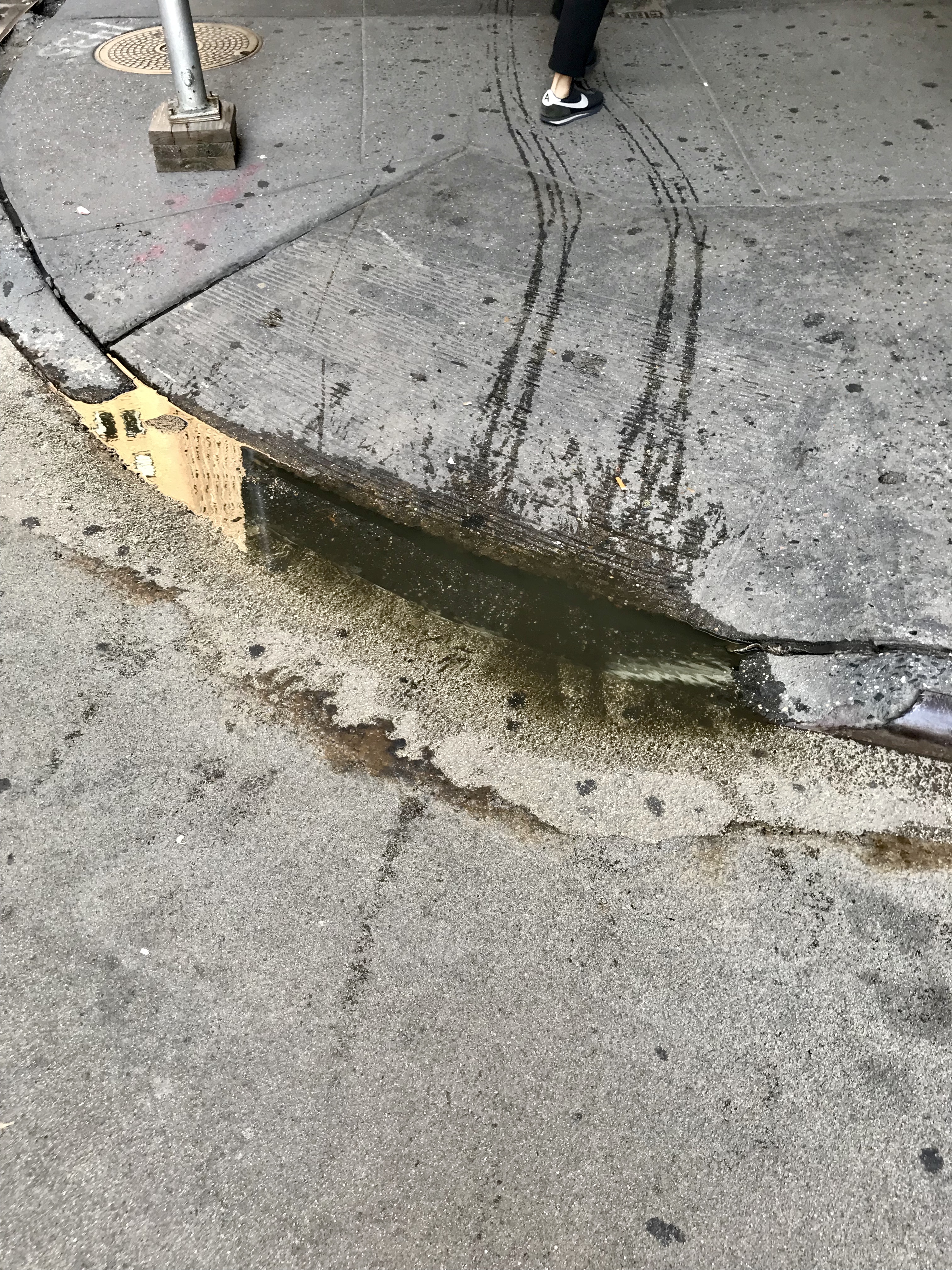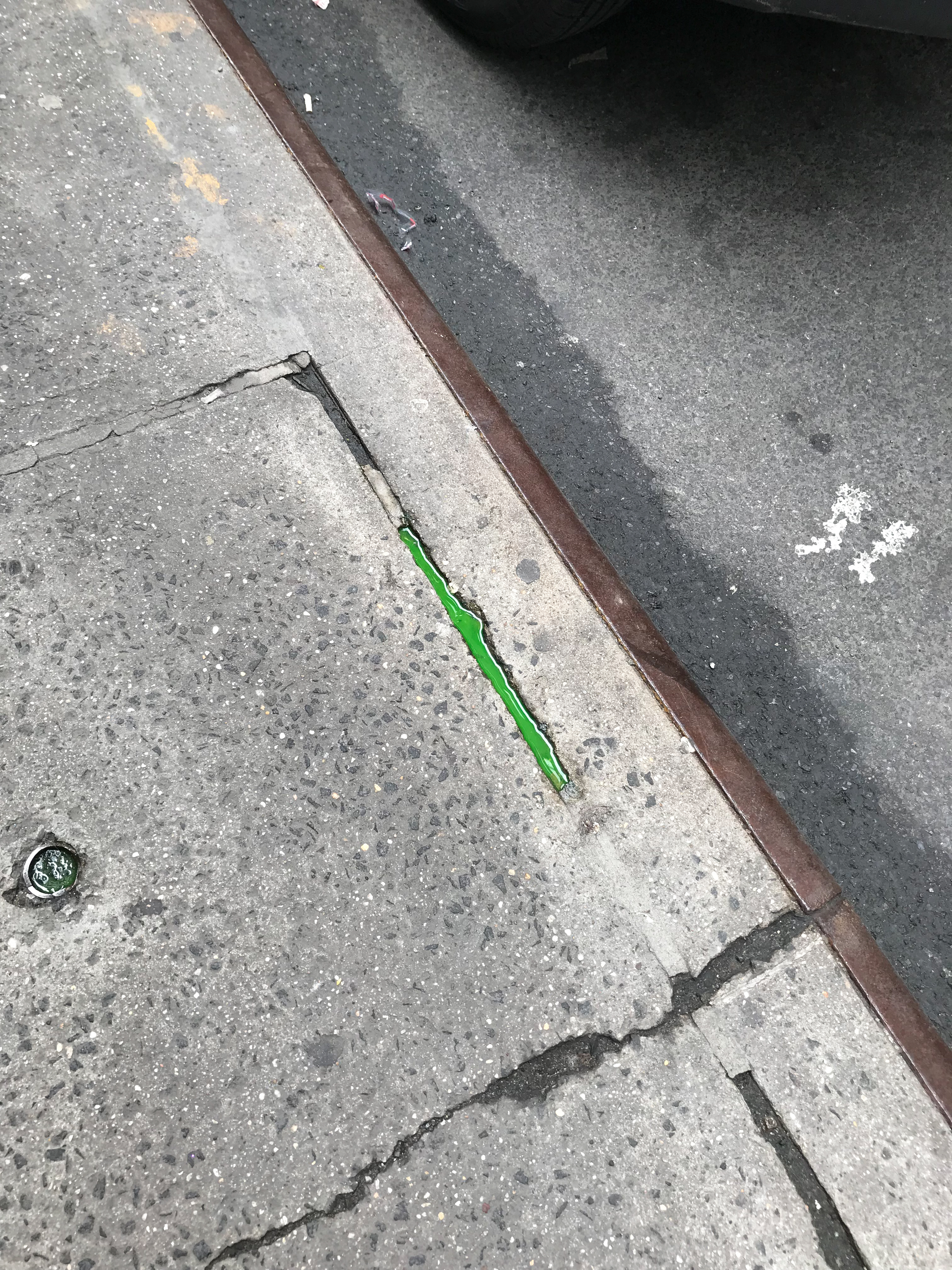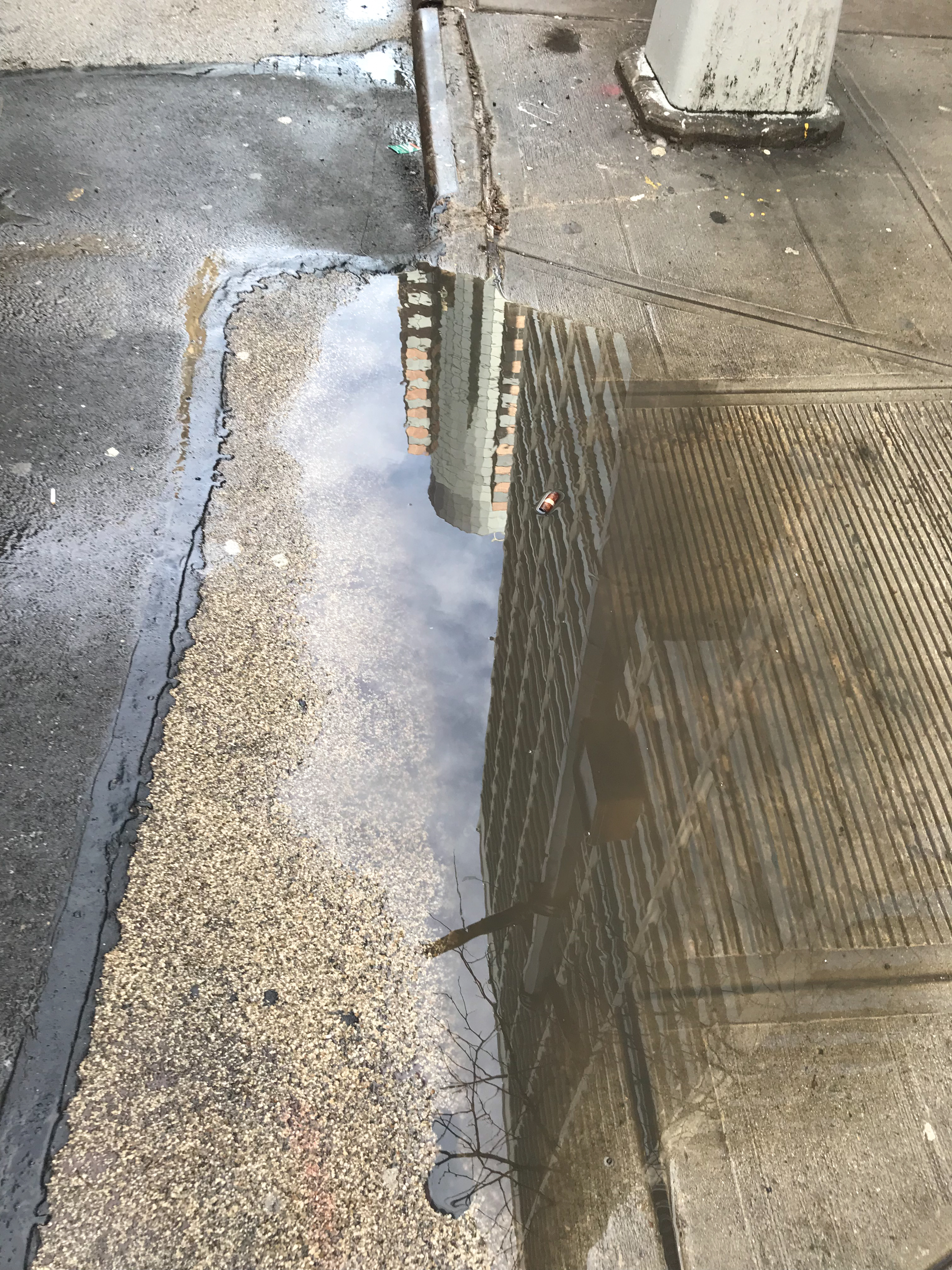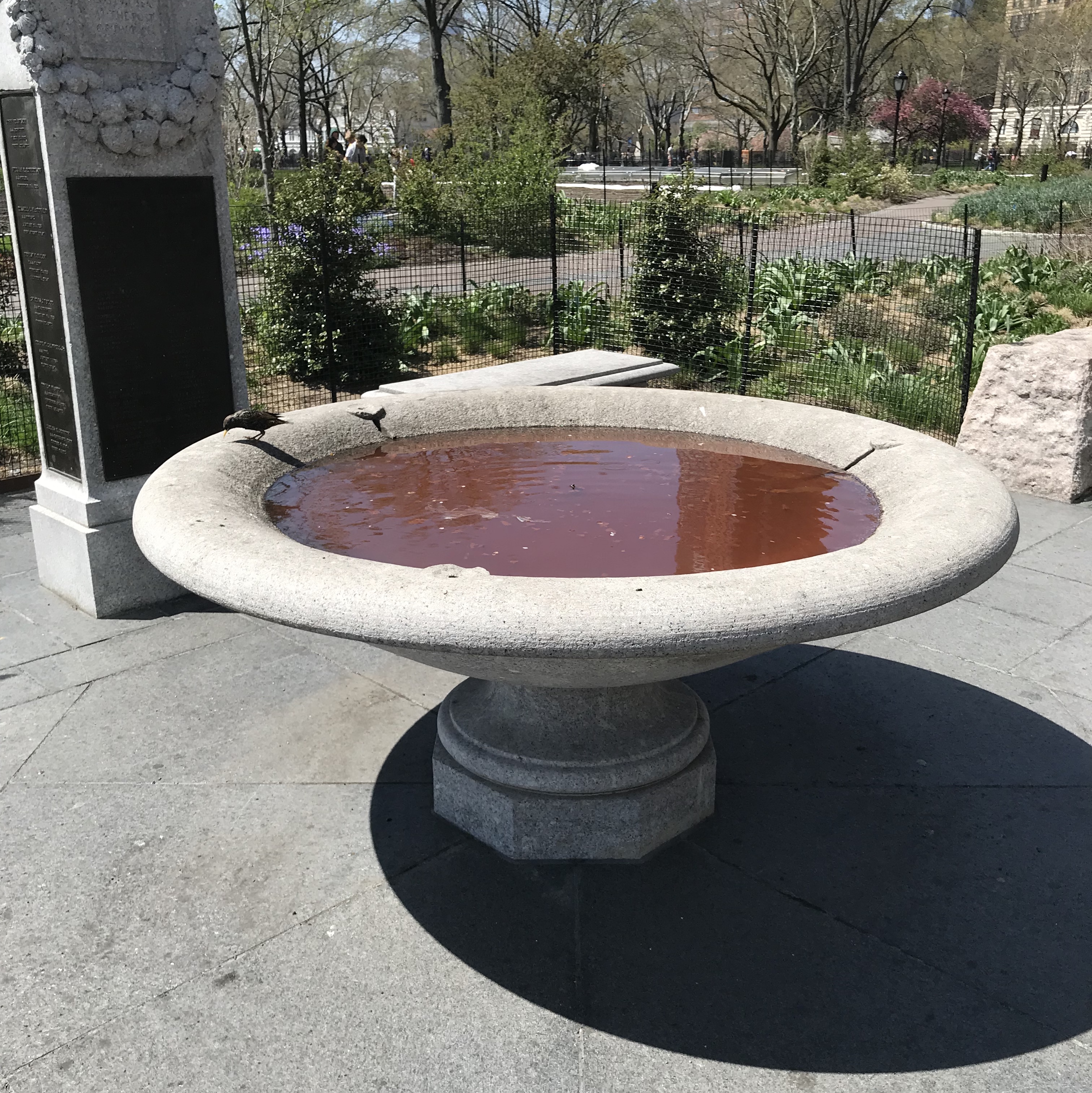How to Encounter a Puddle
Anny Li
Last summer, the New York–based magazine Triple Canopy held its annual Publication Intensive between two sites: New York and Providence. Twelve participants—a diverse group of artists, writers, graphic designers, coders, performers, and educators—took part in seminars, discussions, site visits, and workshops to mine the history of print and analyze “today’s networked forms of production and circulation.” June Yoon (MFA GD 19) and Maia Chao (MFA GL 17) gathered the writings of fellow participants into a booklet of “reflections on a collective experience.” v.1 chose this piece—developed following the author’s participation in Triple Canopy’s Publication Intensive 2018—to share. Thanks to the author and Triple Canopy for their permission to reprint.


Pearl Street (between Wall and Pine). Left to right: September 2017, April 2018, May 2018. Photographs by the author.
About nine months ago I started to notice curious, recurring deposits of fluorescent green liquid in the streets of NYC’s Financial District. One particular patch of sidewalk on my daily commute would regularly accrue a puddle of mysterious liquids that varied in color from day to day. Deep purples, milky pinks, lime greens—(was it antifreeze? Beet juice? Human emissions? These puddles of “city sauce” (as a friend who works in construction affectionately terms it) continued to mystify me, and what began as impulsive photography shifted towards more intentional documentation. In thinking of puddles as more than just temporary accumulations of water, I began to store them as scattered fragments of evidence, documents in and of themselves.
I offer some notes here on the origins, characteristics and peculiarities of the urban puddle.
1. Puddles are documents. As residue or remainder, they are both witnesses to and byproducts of events that may range from things as benign as a rainstorm to more sinister violations such as toxic leakages. But they can be perpetrators too.
2. Puddles are not neutral. If you step in a puddle, you will leave a trail of footsteps behind you. Or, if you are on wheels, there will be a record of that too. Once you enter a puddle you have been implicated by it.

3. As minor bodies of water with no apparent parent source, puddles exist on the fringes. They appear static, yet under constant threat of evaporating and disappearing for good (or until the next rainy day). They are frequently located in the marginal, in-between spaces, framed by a curb and a crosswalk, the sidewalk and the street.

4. Puddles represent transitional states. They are deposited rainclouds waiting patiently to return skywards, or the melted snow or slush after a blizzard. They are both an afterthought and the aftermath (of a storm, of a crime, of the end of a long day’s work).
5. Puddles reproduce the environment around them; they are mirrors, temporary sites of reflection and collection. You can catch a glimpse of the inverted city if their surfaces happen to be still enough.

4. Puddles represent transitional states. They are deposited rainclouds waiting patiently to return skywards, or the melted snow or slush after a blizzard. They are both an afterthought and the aftermath (of a storm, of a crime, of the end of a long day’s work).
5. Puddles reproduce the environment around them; they are mirrors, temporary sites of reflection and collection. You can catch a glimpse of the inverted city if their surfaces happen to be still enough.

7. Puddles thrive where infrastructure fails. They assemble in cracked sidewalks and non-draining curbs. If you pay attention to where they recur, they may indicate leakages or poorly maintained stormwater management systems. They are inconveniencing agents that intrude on our dry ideal. No one likes wet socks.
8. Puddles are biotic containers for precarious ecosystems. Standing bodies of water might become a threat to humans while serving as a haven for other creatures. (The City of New York advises citizens to report chronic puddles, as mosquitos breed in water left standing for more than five days.2) If a puddle outstays its welcome, it becomes a home for new organisms.

9. Puddles are equivocal, promiscuous, shallow, overlooked, ignored. They are undiscriminating infiltrators and will occupy any hole.

10. Puddles don’t exist in isolation, but rather as a decentralized network, flourishing in rogue locations. By documenting them, we archive a city constantly in flux.
What can be learned from the humble puddle? I wonder how they could present new models for publication.3 To this end I think too of Jack Halberstam’s “low theory” in The Queer Art of Failure, where he outlines inroads to non-dominant and resistant modes of being, knowing, and learning, recuperating failure as a practice and locating sites of “more creative, more cooperative, more surprising ways of being in the world.”4 Similarly, the puddle may lead a precarious existence, but it thrives in these very same in-between, overlooked spaces. A puddle infiltrates, interferes, and ultimately vanishes, only to replenish itself anew.
To close this brief meditation, a note on the methodology of documenting urban puddles: It begins in the street. You cannot be afraid to break sidewalk etiquette, block the crosswalk, or interrupt traffic. Stop and look at the puddles—murky waters are deeper than they appear.
1. An aside: “Poodle” is an etymological descendant of “puddle,” as shortened from the German pudelhund or “water dog,” as the dog was likely named since it was used to hunt waterfowl in the 17th century. Pudeln in Low German means “to splash.”
2. www1.nyc.gov/nyc-resources/service/2510/standing-water-complaint
3. Laurel Schwulst has written poetically about artist’s websites as puddles (thanks to Willis for pointing me to this): https://thecreativeindependent.com/people/laurel-schwulst-my-website-is-a-shifting-house-next-to-a-river-of-knowledge-what-could-yours-be
4. Jack Halberstam, The Queer Art of Failure (Durham, NC: Duke University Press, 2011), p.2.
Anny Li lives, writes, and documents in New York.